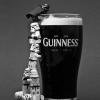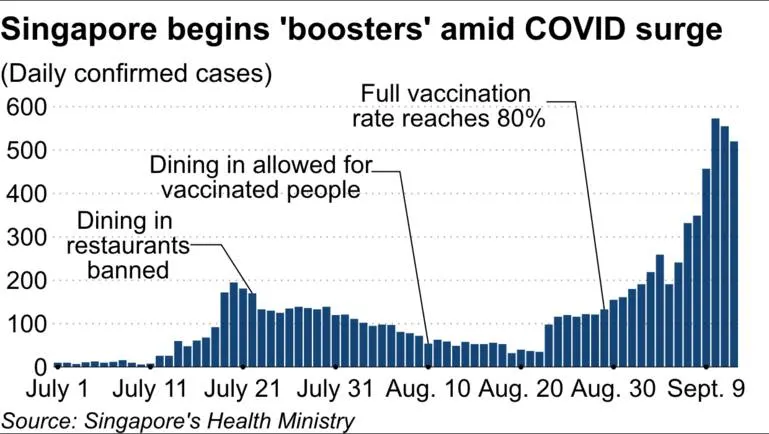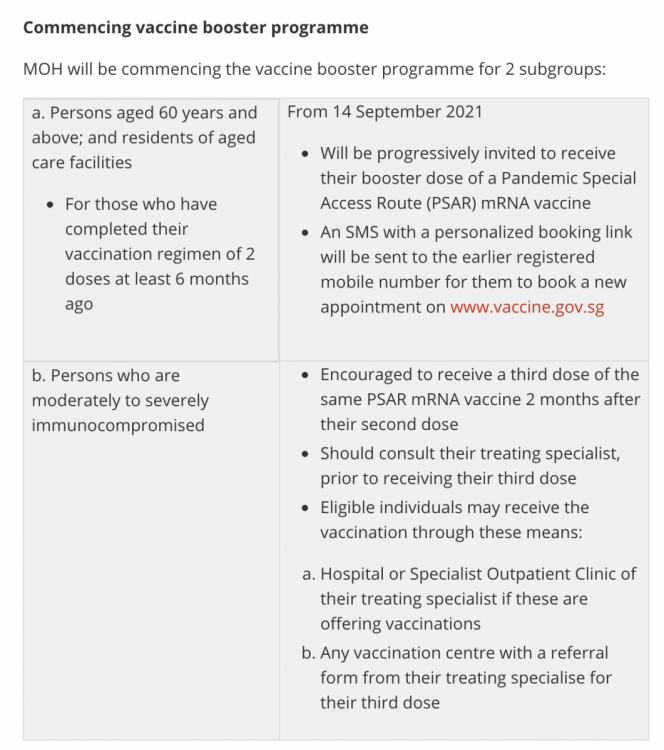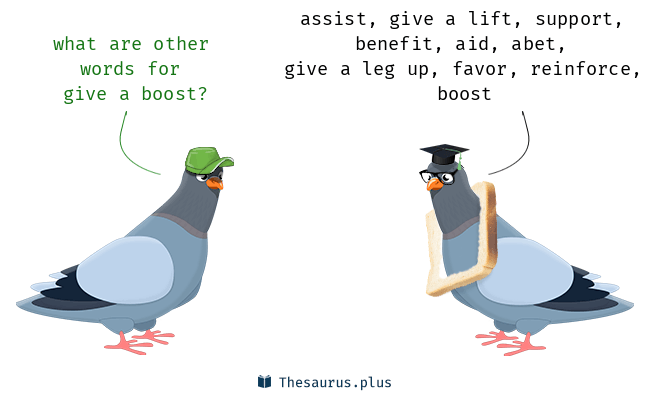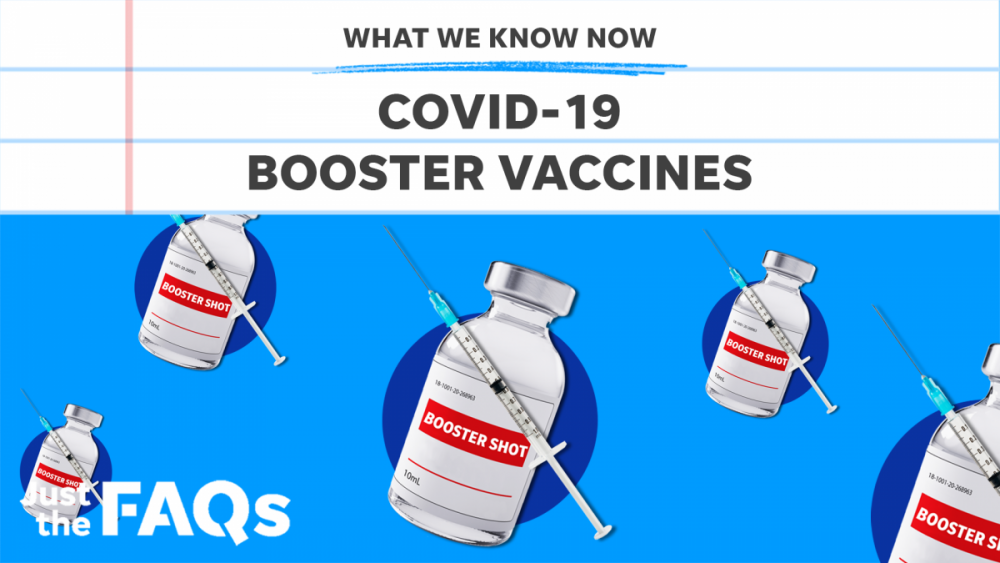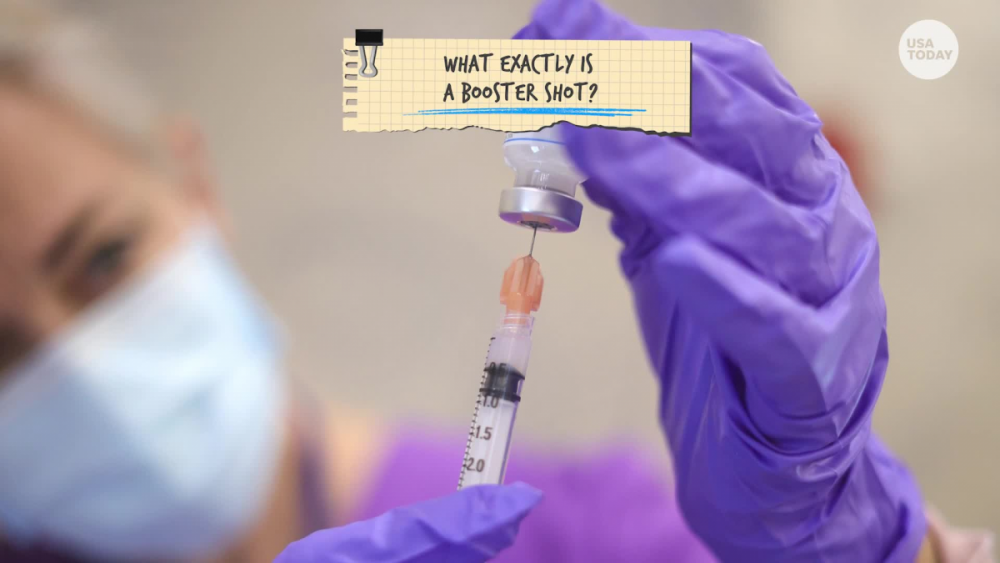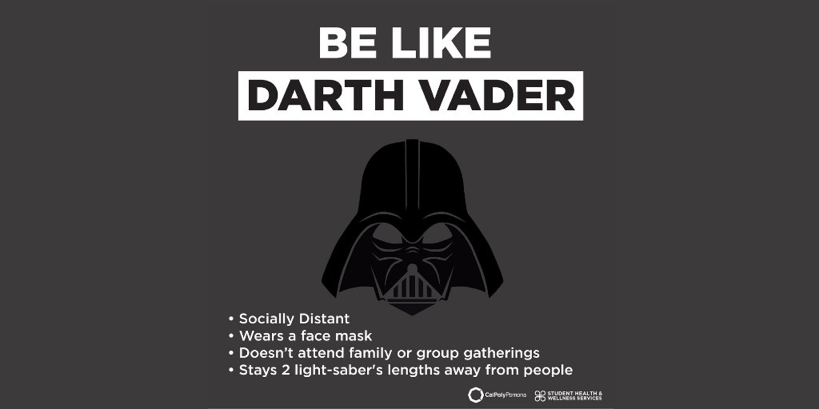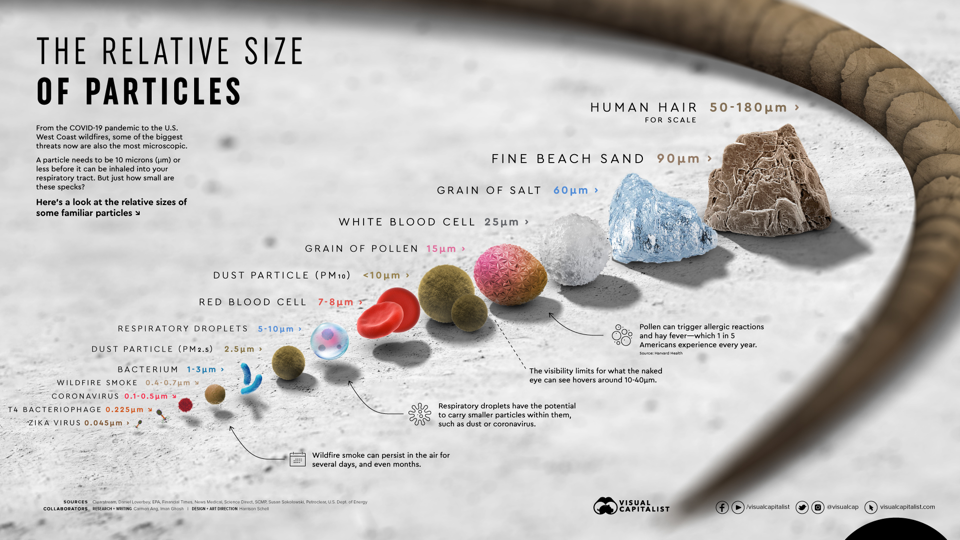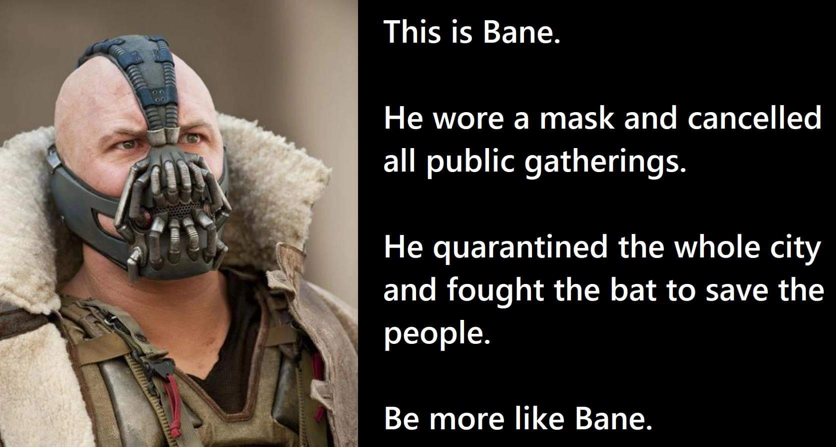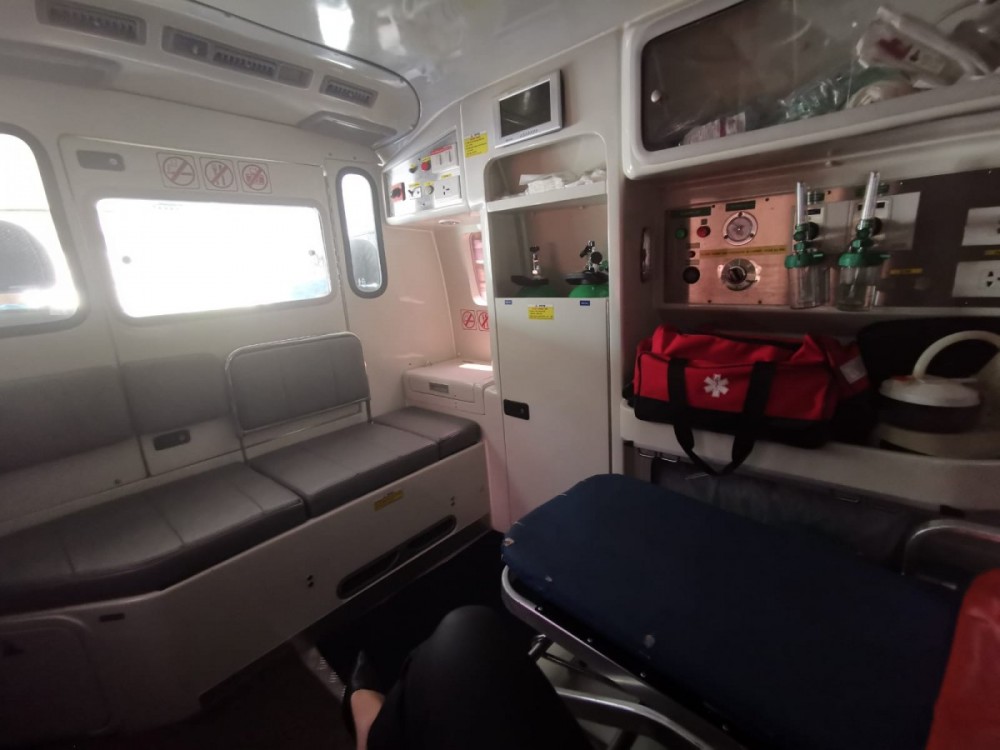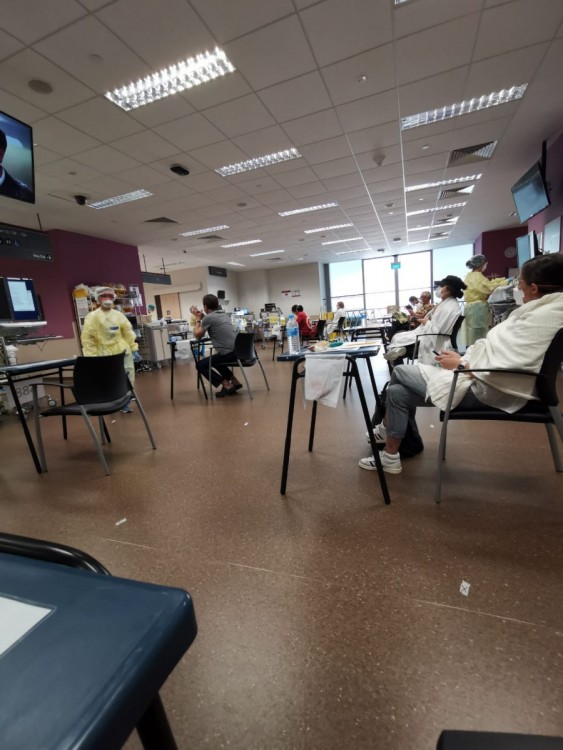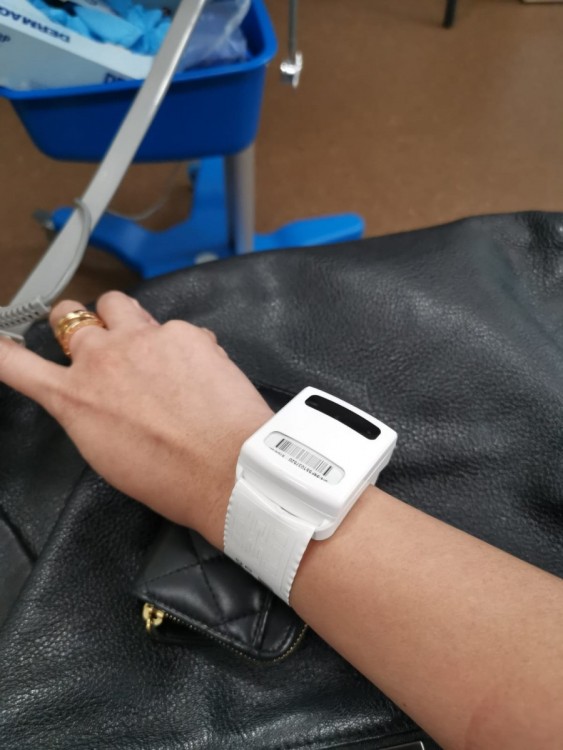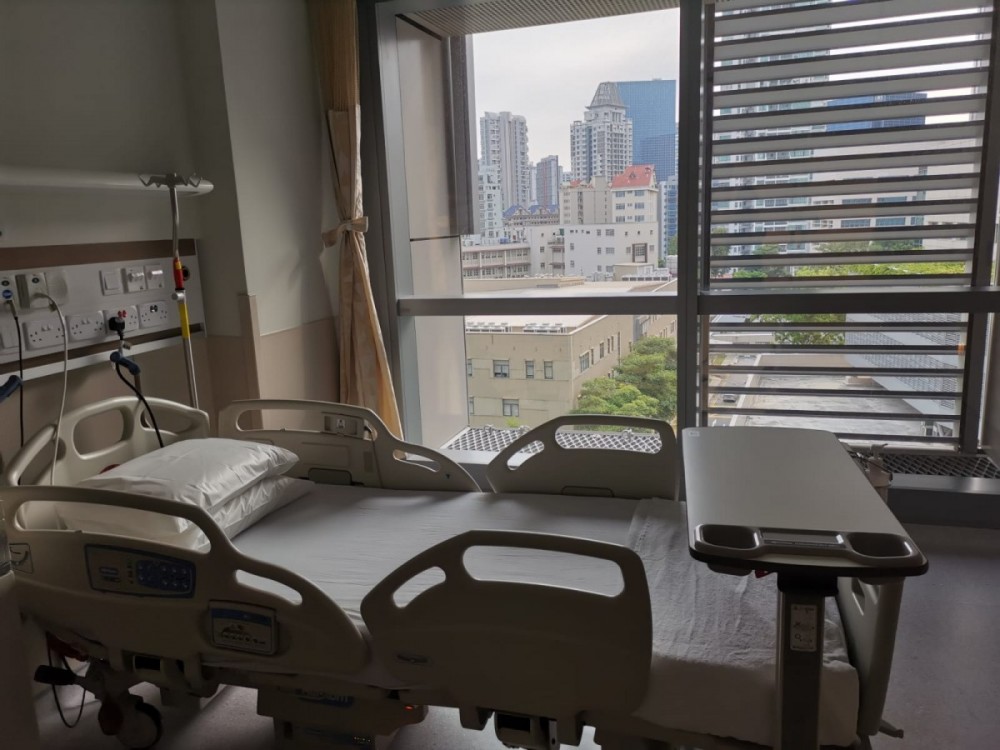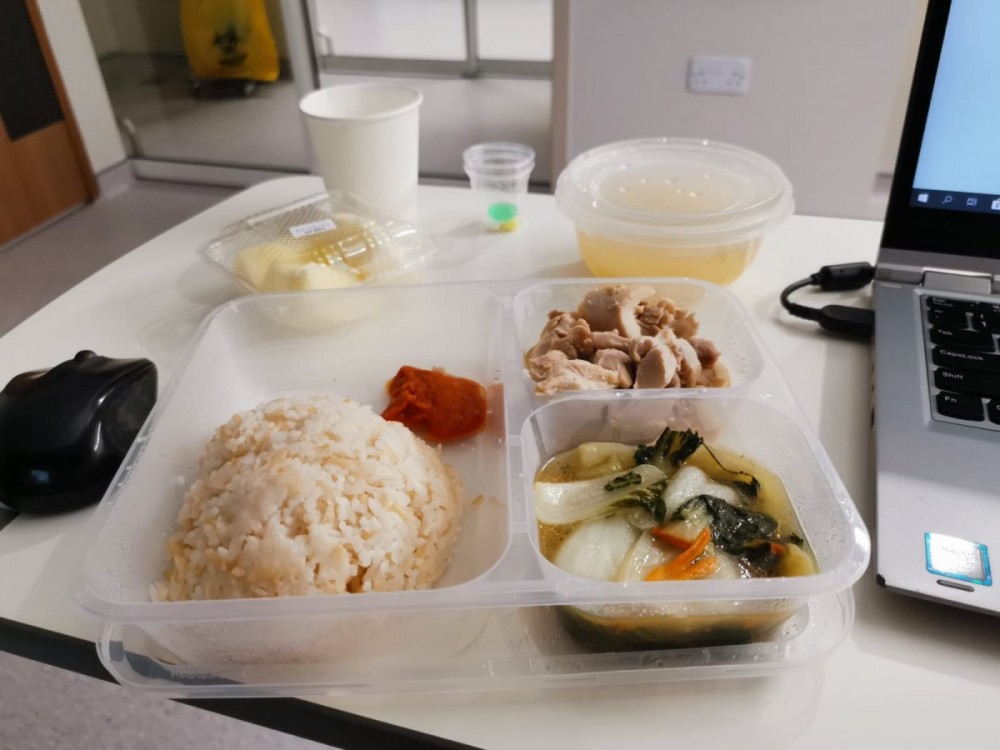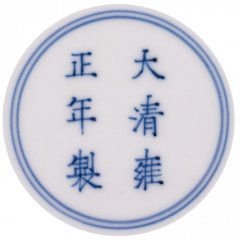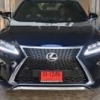Search the Community
Showing results for tags 'covid'.
-
https://www.channelnewsasia.com/commentary/work-life-balance-covid-19-hybrid-remote-great-resignation-wave-jobs-2682751 Many of us hold on to work-life balance as an ideal, without acknowledging the blood and sweat that make it possible in the first place, or how it’s not always feasible in our circumstances, says business writer Keith Yap. SINGAPORE: Since the COVID-19 pandemic began, working norms, especially in knowledge-intensive industries, have changed forever. Many of us have become skilled practitioners of working from home, attending Zoom Meetings with smart tops and pyjama bottoms, and eating lunches with Netflix instead of co-workers. In light of other trends like employees reconsidering their priorities and quitting their jobs, the narratives surrounding the future of work has percolated into online discourse. From TikTok to Harvard Business Review, the Internet is replete with advice on navigating this brave new world after the pandemic. While narratives about work are varied and fragmented, the motif of workers' burnout remains consistent. As offices in Singapore fling their doors open to welcome back all workers, many are pushing back against burnout in favour of pursuing work-life balance. Many of us visualise a seesaw when thinking about work-life balance, with the ideal of work and life on both ends perfectly level. It’s a zero-sum game and our language reflects any perceived imbalance – work “eats into” our weekends, we worry about "sacrificing" careers if we have kids and take parental leave. The hypothetical employee who’s achieved the coveted work-life balance looks like this: They enjoy autonomy in their professional life. They work a remote job, log in at nine, be ultra productive and go offline at six, commuting to the office only twice a week. They can reject all work communication outside of those hours. The rest of their time is protected for better pursuits, dedicated to dabbling in the guitar, cooking risotto for the family and catching up with pals every week. JOB MOVEMENTS AREN’T ALWAYS LIFESTYLE UPGRADES But a closer look reveals two key problems. First, a rigid conceptualisation of balance assumes such a lifestyle is immediately attainable for everyone, especially more junior employees. The Great Resignation Wave should not conceal the fact that many workers are leveraging the moment to move up in the same industry to get higher pay and more flexible work arrangements. But to make such moves, workers need bargaining power. They do this by spending most of their waking lives for years honing their craft, developing an edge to differentiate themselves in a crowded labour market. If workers at the beginning of their career prioritise flexibility and autonomy, they will end up compromising on picking up and perfecting skills required for career progression. Granted, one can reject the prospect of sprinting up the corporate ladder and trade progression for flexibility. This trade-off is laudable for some but impractical for others. However, current discussions assume job movements are unconditional lifestyle upgrades, without acknowledging the blood and sweat that made them possible. And with the new slate of responsibilities, the exigencies of work might mean compartmentalising work and life becomes even more challenging for all but the most senior roles. COMPANIES CAN’T ALWAYS PROMISE WORK-LIFE BALANCE With the spotlight on employee well-being, companies are embarking on more initiatives like offering mindfulness workshops or meditation apps, even giving employees mental health off days. Workers point out such efforts do not address the root cause of burnout: Exhausting work conditions. More are calling on corporate leaders to re-examine working hours and their expectations of employees. But here lies the second problem: Despite the best efforts of employers, the realities of work often make it difficult for companies to promise work-life balance. Any seasoned worker knows projects often take more time than expected and are prepared to work overtime to meet deadlines. The inconvenient truth is that a company exists for-profit and must outperform competitors. Thus the paradox of work-life balance is two-fold. To provide it indiscriminately, the company risks compromising its mission. To pursue it indiscriminately, the worker risks compromising career progression. EMBRACING WORK-LIFE RHYTHM INSTEAD It might be high time to discard the term “work-life balance” and that mental image of a seesaw. Let’s embrace instead the pursuit of a healthy “work-life rhythm” - a rhythm that moves with need, alternating between periods of hard work and deep rest over time. This can facilitate professional development and organisational growth while alleviating worker burnout. During periods of hard work, the worker is focused on project completion and will expect an intense workload. This could mean working past office hours regularly or even burning the midnight oil on some occasions. In return, companies can guarantee a minimum of work-free hours (such as weekends or mass block leave) so workers can tend to their personal lives. Conversely, professional obligations would be kept to an absolute minimum during periods of deep rest. During a company-wide lull, staff don’t have to worry about lingering work responsibilities, and can take on new hobbies or go on extended vacations. This would mark a divergence from our current practice of leaving workers to manage their leave schedule. Wouldn't we feel a nagging pang of guilt if we scooted over to Bali while our colleagues were working, even when we intuitively know there is not much to do? Conversations on work-life rhythm aren’t yet mainstream, though proponents compare it to seasons. Just as there are seasons for planting, harvesting and resting, we go through life phases where we can give our all to work – whether it’s building a business or designing a product – and where we must dedicate ourselves to family. Beyond the debate whether we should shift towards four-day work weeks, perhaps we should also be talking about 10-month work years. A GREATER APPRECIATION OF LIFE WITH EXTENDED PERIODS OF REST As a healthy work-life rhythm will benefit Singapore greatly, the Government can take the lead, as it has done so by calling for flexible work arrangements to become a permanent feature. The Government can continue actively engaging industry players through incentives and dialogues to shape better work norms. At a national level, such a work-life rhythm creates a society where no one is compelled to work laboriously throughout the year. It could empower more individuals to devote their spare time to work of public importance such as volunteering, political participation and the arts. Other more career-minded ones would improve their skills to be more productive at work. Most importantly, there will be a greater appreciation of life with extended periods of relaxation. We can focus on our family and friends, which goes a long way in countering burnout, cynicism and angst. COVID-19 has forced us to re-imagine the future of work. It might be time to retire the pursuit of the ever-elusive work-life balance. After all, isn't the whole point of a seesaw to enjoy the alternating rhythm of ups and downs instead of always toiling to balance ourselves perfectly?
-
Friends I'm sure lots of us have been doing zoom calls, so what have you been using? My own office is a big mess, it looks like a tornado tore through it. My own home isn't ideal, so I either have a nice background or no video... You have to try the background first. Sometimes you may look like a floating head, or a bald guy with it... So do show your backgrounds 🙂
- 16 replies
-
- 1
-

-
- zoom
- backgrounds
-
(and 3 more)
Tagged with:
-
So now that we have reached a significant percentage milestone of vaccination, is it all green light now? Well, now comes the booster shot 🙂 Where to register: https://www.vaccine.gov.sg/ Why booster? https://www.usatoday.com/story/news/2021/09/13/covid-19-vaccine-booster-shots-who-can-get-them-when-still-uncertain/5773405001/ https://www.gov.sg/article/expanding-testing-and-surveillance-and-introducing-a-national-vaccine-booster-programme https://www.nature.com/articles/d41586-021-02158-6 Booster vaccination strategy MOH, with advice from the Expert Committee on COVID-19 Vaccination (EC19V), has reviewed the vaccination strategy in light of the more transmissible variants that have emerged globally. Although evidence globally and locally continues to show that vaccines are very effective in reducing severe illness and death, there is emerging data on the waning of vaccine efficacy against infection with time. MOH and EC19V will commence a booster programme for two groups of individuals: (A) Persons who are moderately to severely immunocompromised They are recommended to receive a third dose of the same Pandemic Special Access Route (PSAR) mRNA vaccine two months after their second dose as part of their primary course of vaccination regimen. They should be referred to do so by their doctors who have the best understanding of their medical condition. These include persons with the following conditions: Transplant patients on medications that suppress the immune system, including solid organ and allogenic stem cell transplants Cancer patients on active treatment with chemotherapy or on other therapies that suppress the immune system Haematological cancers Treatments for non-cancer conditions that suppress the immune system End-stage kidney disease on dialysis Advanced or untreated HIV (B) Persons aged 60 years and above and residents of aged care facilities They are recommended to receive a booster dose of PSAR mRNA vaccine six to nine months after having completed their primary course of vaccination regimen. The first batch of seniors aged 60 years and above completed their second doses around March 2021 and therefore will be eligible for the third dose within the month of September. More details on the implementation of the booster shot will be announced later. Not this type of booster ya https://asia.nikkei.com/Spotlight/Coronavirus/COVID-vaccines/Singapore-starts-booster-shots-as-COVID-cases-hit-1-year-high
-
https://www.reuters.com/investigates/special-report/usa-covid-propaganda/ The U.S. military launched a clandestine program amid the COVID crisis to discredit China’s Sinovac inoculation – payback for Beijing’s efforts to blame Washington for the pandemic. One target: the Filipino public. Health experts say the gambit was indefensible and put innocent lives at risk. At the height of the COVID-19 pandemic, the U.S. military launched a secret campaign to counter what it perceived as China’s growing influence in the Philippines, a nation hit especially hard by the deadly virus. The clandestine operation has not been previously reported. It aimed to sow doubt about the safety and efficacy of vaccines and other life-saving aid that was being supplied by China, a Reuters investigation found. Through phony internet accounts meant to impersonate Filipinos, the military’s propaganda efforts morphed into an anti-vax campaign. Social media posts decried the quality of face masks, test kits and the first vaccine that would become available in the Philippines – China’s Sinovac inoculation. Reuters identified at least 300 accounts on X, formerly Twitter, that matched descriptions shared by former U.S. military officials familiar with the Philippines operation. Almost all were created in the summer of 2020 and centered on the slogan #Chinaangvirus – Tagalog for China is the virus. READ MORE https://www.reuters.com/investigates/special-report/usa-covid-propaganda/
-
We all missed being able to travel during the dark and uncertain days of the COVID-19 pandemic. Even when Vaccinated Travel Lanes were introduced, few of us were interested. After all, undergoing numerous PCR tests is uncomfortable and being subject to quarantines, especially if you catch COVID, is hardly how anyone wants to spend their holiday. So, a lot of folks became 'tourists in their own country'. And staycations, or staycays for short, became popular. Being cooped up in one's home for too long does that to people. But now that we can freely travel without needing PCR tests and quarantines (and face masks for that matter), some have opined that staycays are no longer relevant. I, however, think otherwise. Here are five reasons why. Photo: Paolo Nicolello, Unsplash 1. It's less of a hassle compared to going overseas. Planning an overseas holiday is complicated. You need to book flights, consider where you'll be staying and figure out an itinerary. That means you'll have to do research (Google and YouTube) to come up with a list of places and activities to do at your destination. This also results in having to figure out the logistics and transportation that go along with said activities. How difficult this will be is subjective. But some form of planning is required. In comparison, a staycay only requires me to plan when to take leave and check out the room rates for the hotel my wife and I wish to stay in. Then, we just pack light. There is no need to wake up early or stay up late to catch a flight. Flying off to another country is fun, but it requires planning, time and effort 2. Forgot something? No worries. One of the advantages of staycationing is convenience - you don't have to go or look far to find say, toiletries or swimwear. There's also no need to exchange currency (or worry about exchange rates and which money changer to go to). I don't have to subscribe to a roaming service either. One thing that worries me before my wife and I fly overseas is whether we've left anything charging. If we're on a staycation, we wouldn't be concerned because hey, if needed, we can return home to check. Not having to worry about such things is why staycations can be more stress-free compared to a holiday overseas. You can still eat well in Singapore - just go to your usual haunts while on a staycation 3. There might be food issues. Trying new food is one of the biggest reasons for exploring other countries. You can really get to know another country's culture by keeping an open mind and sampling their local fare. However, not all of us are fortunate enough to have travel companions with the same mindset. If your family members are the type who 'can only eat local food' or worse, only want to patronise restaurants from global F&B chains, holidaying overseas is probably inconvenient for you. But if you're on a staycation, then your less adventurous family members should have less to complain about, which might result in less stress for you as well. Hotels like Dusit Thani Laguna Singapore can make you feel like you're in an overseas resort, even if you haven't left the country 4. Consider medical concerns. Not everyone is blessed with good health, even for those who work out regularly and watch their diet. Sometimes, genetics just gets the better of you. If you have family members that can't travel due to underlying medical concerns, a staycation is a good alternative. Frankly, being able to find a hotel that gives you the feeling that you're not in Singapore is not easy. But perhaps a getaway to Sentosa (which is not on the 'mainland') might suffice. Although you'd still be in Singapore, staying at a hotel means not having to clean your room or worry about running the air-con 24/7. Not having to think about chores is a stress-reliever, which is what holidays are about. 5. Staycations generally cost less. A three-night stay at a local hotel (provided you haven't booked the Presidential Suite and aren't eating all your meals there) can be cheaper than a six-day holiday overseas, so when I feel like I need a quick break from work, a staycation really does the trick. Well-meaning colleagues always mention that part of the hotel budget could have been used for air tickets. Or that we should have redeemed our miles instead. But these suggestions overlook the fact that going overseas entails other costs as well. These include currency exchange, your hotel, food, and pocket money for shopping. When we're overseas, there's a tendency to want to eat more food and buy more stuff because you might not find the same things back home.
- 1 comment
-
- 2
-

-
- staycation
- staycay
- (and 10 more)
-
It's now 2024, and Covid is still with us. People don't go into a frenzy now, and there are no toilet roll runs, but the fear is still around, just in variable amounts and in different intensities. I doubt that anyone could have imagined this back in 2021 or even 2020.. So what's new in 2024? 1 - Our current flavor? BA. 2.86 or JN. 1 There are still vaccines, and they tell us it covers this strain 2 - it is unlikely that we will close down and have a circuit breaker, just because of the economic costs, rather than any health advice 3 - masks are still required in health care settings, elsewhere, it's up to you 4- are there any positives? I think there are some small ones: - the whole home delivery industry took off, especially food delivery - we now have an ability to work from home, well not everyone, but many - some of us respect those in the healthcare industry more - we have become more health aware of viruses, transmission, infection and hygiene.. we may not be more hygienic, but we are more aware of what it takes to get infected - some of us have decided to live life differently and not take life for granted - others still have a stockpile of toilet rolls, medication, and of course masks Who still keeps a ton of masks at home? I do, from surgical, to cloth and of course N95 ones. I still have sanitizers all over the home and use alcohol to wipe surfaces like keyboards and phones.. How has your life changed?
- 6,298 replies
-
In light of the current Covid situation as well as the coming dry months with the haze coming, I recently had to do a presentation on this, so I figured I should the info here for all to benefit and also share, and others can contribute, discuss etc. 1 Firstly, I have no financial interest in the items I share.. 2 Second, what's an Air Purifier? An air purifier or air cleaner is a device which removes contaminants from the air in a room to improve indoor air quality. 3 What are the common contaminants? Before Covid, we had the Haze, and the keyword is PM 2.5 https://www.health.ny.gov/environmental/indoors/air/pmq_a.htm These are particulate matter 2.5 (PM2.5), refers to tiny particles or droplets in the air that are two and one half microns or less in width. Exposure to fine particles can also affect lung function and worsen medical conditions such as asthma and heart disease. Scientific studies have linked increases in daily PM2.5 exposure with increased respiratory and cardiovascular hospital admissions, emergency department visits and deaths. Then biological contaminants, which include bacteria, viruses and others like fungal spores. 4 So now the hot item is the Covid virus, which requires some of the finest filters known to man: BUT I want to emphasise, the key thing for Covid and general health especially for airborne / aerosol based infections, is the MASK. So before you rush out to buy that purifier, buy and wear that mask! And do your social distancing!
- 30 replies
-
- 5
-

-
- air purifier
- hepa
-
(and 3 more)
Tagged with:
-
Was reading the new below and suddenly have this question in my mind. I am more on the side that group buy is like a trip to the supermarket, provided that everyone observe the safety measures spelled out by MOH. But some of these groups can involve >100 members at its peak, so can the measures be adhered to all the time? Not just free delivery and bulk discounts: The rise of community group buys in Singapore https://www.channelnewsasia.com/news/cnainsider/free-delivery-bulk-discounts-singapore-rise-community-group-buys-15240638 SINGAPORE: In the year or so since Mrs Tan began joining group buys, she has seen everything from high-quality fresh fruits to microfibre cloths to ergonomic chairs being hawked at a discount. Today, the 31-year-old, who wished to be identified by her last name only, estimates that half her groceries come from orders placed through chat groups on WhatsApp or Telegram run by others in her estate. “While the prices weren’t necessarily cheaper than in a neighbourhood supermarket, we felt the fruit and vegetables were significantly fresher than what we were getting. We eat a lot better with the same amount of money,” she said. She also appreciated the flexibility and convenience of being able to pick up her items at her neighbours’ homes. This process, known as group buying, involves people in the same estate banding together to place bulk orders for items in order to cut delivery costs and enjoy discounts from suppliers. And it is gaining traction in Singapore, fuelled by COVID-19 restrictions. A simple search on Instagram yields more than 50 group-buy profiles tagged with the names of different estates. Group buys have also sprung up island-wide based on shared interests, like for those buying children’s toys or for couples looking to renovate their homes. But even as it appears that the primary aim of group buys is to get a good deal, other side benefits have emerged along the way. Even hawkers are benefiting, though the question remains: To what extent? And while there is uncertainty about breaching regulations in running group buys, the positives outweigh the drawbacks, so far, for the likes of Mrs Tan.
- 22 replies
-
- 8
-

-
- covid
- heighthen alert
-
(and 2 more)
Tagged with:
-
Lai lai lai, suggestions for 4D numbers. Buy simi lumber? https://www.asiaone.com/singapore/pm-lee-catches-covid-19-first-time?utm_source=a1home&utm_medium=referral&utm_campaign=A1+trending&utm_content=c1
-
https://www.todayonline.com/singapore/adulting-101-untimely-deaths-friends-existential-crisis-2131826 Adulthood is an invigorating stage of life as young people join the workforce, take on more responsibilities and set their sights on the future. But its many facets — from managing finances and buying a home to achieving work-life balance — can be overwhelming. In this series, TODAY’s journalists help young Singaporeans navigate this stage of their lives and learn something themselves in the process. SINGAPORE — In the last two years, five people I knew died from sudden cardiac arrest. They were young and seemingly healthy people whose untimely demise came as a shock to their family and friends. They ranged in age from about 25 to 35. The grief hit me pretty hard, as I felt a lot of guilt and regret about my relationship with some of them. It got me to thinking — are more young people dying from sudden cardiac arrest? And should I be worried? Cardiologists from the National University Heart Centre Singapore told me that the risk of sudden deaths in young people remains exceedingly low. Based on the out-of-hospital cardiac arrest (OHCA) data report published by the Singapore Heart Foundation four years ago, those above the age of 65 constitute the highest risk group of patients, accounting for 36.2 per cent of the 3,000 cases of cardiac arrest in 2019. There are about 3,000 cases of OHCA yearly here. One cardiologist told me that the prevalence of OHCA in Indians and Malays is twice the rate of Chinese. The prevalence of OHCA in men is also twice that of women. While uncommon, there are underlying conditions among young adults that can lead to sudden deaths, such as hypertrophic cardiomypathy (abnormal thickening of heart muscles) or arrhythmias (abnormal heart rhythm of genetic causes), another cardiologist said. This is why health screenings are important, as people often believe themselves to be healthy if they do not have any symptoms of underlying disease when they may have conditions that are asymptomatic. Though sudden cardiac arrest among young people with no underlying conditions is rare, I could not shake this feeling that my life could be taken from me at any time. This led me to move beyond concerns over cardiac arrest affecting the young to wonder more broadly at the meaning of my brief, mortal existence. I was left feeling unmotivated and uneasy. Don’t get me wrong, my life is going okay — I have a good job, I have a roof over my head, I have two beautiful kids and a supportive husband — but I was being consumed by this thought that if life is so short, why bother doing anything? It occurred to me that I was perhaps having an existential crisis. Mr Praveen Nair, a psychologist at Raven Counselling and Consultancy, said that this occurs when there is an inner conflict within an individual causing them to break from traditional thinking patterns and recalibrate to become more contemplative with regard to questions about meaning, purpose and identity in life. Mr Nair also reassured me that I am not the only one feeling this way, as he has seen more adult clients with similar issues. One contributor to this is social media, said Mr Nair, as some netizens cherry pick what they share online to present a rosy picture of their lives, which can cause other users viewing the content to experience "fomo" (fear of missing out). This, in turn, can lead them to wondering about their direction in life. Mr Nair said it is normal to experience an existential crisis even when things in your life seem to be going okay as many things, both overt and subliminal, can influence our thoughts even when our lives are relatively routine. In fact, some argue that the mundane and routine can be a stimulus to initiating thoughts about the larger meaning or purpose of life. This makes sense, as I have been feeling a certain kind of tedium for some time now, juggling work and caring for two young children daily. Ms Abigail Yang, a grief therapist at counselling platform Talk Your Heart Out, said that it is normal to think deeply about life or question how you feel about it. The more fundamental issue is when no answer satisfies you, she added. “It becomes a constant loop of complex questions with no fulfilling solution. This, in turn, leads to a conflict within yourself about your reason for existence,” said Ms Yang. In some cases, extreme thoughts and unanswerable questions can leave one feeling frustrated, anxious, depressed and even suicidal, said experts. They also shared that one way to overcome an existential crisis is to disengage from pursuits or people that bring me no joy and redirect my energy to those that do. Mr Nair said this can help initiate renewed drive and motivation in life. “It may sound counterintuitive but many great innovations occurred when inventors experienced an existential crisis. They channelled their energies into a new venture that was motivating,” he told me. One way to overcome the crisis is to also take time to connect more with people whose company I enjoy, as an existential crisis can occur when we feel disconnected from others, said Mr Nair. Ms Yang reminded me that it is okay to allow myself to feel such negative emotions, and that I should not suppress them. Some people block out pain and suffering, thinking this will make them happy, but it can often lead to a false sense of happiness, she said. Embodying emotions and acknowledging feelings of pain, discontentment and dissatisfaction can open the door to personal growth, and improve one’s outlook on life, Ms Yang added. One tip I got from a friend that has helped me deal with my existential crisis is this: "KonMari" your schedule, rid yourself of self-imposed duties and obligations and identify areas where you could be doing less, doing something easier, or doing nothing at all. This is a reference to Japanese author Marie Kondo and her ideas about ridding our lives of needless clutter. This might mean, for instance, your one-hour exercise routine becomes a 20-minute one, or perhaps you ditch it all together for an extra hour of sleep. The only person that should be happy with the choice you make is you. ABOUT THE WRITER: Nabilah Awang, 29, is a former Senior Journalist at TODAY.
- 101 replies
-
- 1
-

-
So now that it's been more than a week already, I can happily to report that we've had (or rather, my gf has had) first-hand experience of SG's super tok kong healthcare system. Just last Monday, about +1 week after our return from Japan (we went before Japan cases boomzed) she developed a sore throat and because of social responsibility, went to see the doctor just before going to work. But because of her travel history to Japan, at the clinic, she was immediately categorised as someone of high risk and was placed into an isolated waiting room. The Clinic also immediately called for an ambulance to send her to NCID as per SG protocol. All this was before she got tested. At NCID, she was given a GPS tag on her arm (so she cannot run away) and had to wait for her Xray. Everyone was spaced apart and most ppl were calm. She did complain everyone else around her was coughing. Unfortunately for her, the x-ray showed a bit of infection and she was immediately warded in an isolated private ward at TTSH where she needed to get tested for the wuhans, in order to be discharged, she needed to clear the test (I think) twice over 2-3 days before they will give her the all clear. The test was the only thing she complained about as they had to insert a long stick into her nose to get the swab sample. It took around 6 hours for the results to arrive. Through her stay, nurses and doctors will occasionally check in on her (in full protective gear) and with free Aircon,WIFI, TV and food, she really didn't mind it all too much. She had a nice view from her room too. There is a box in the wall where they put her food in and can only be opened from either side one at a time. She was allowed one single delivery from outside for her necessities for the next 2-3 days. BUT, I was not able to send it over as my travel history to Japan meant I was not allowed to step into the hospital at all. Even though I had no symptoms. Thus, I packed all her things and sent it to her brother/mother to deliver. Of course I did the "put bag down, spray disinfectant on it, then step away" delivery method. After 2 nights, she cleared both test with no Covid detected and was given the all clear to be discharged. NCID ppl did her paperwork in the afternoon and she was out once she got some meds for her infection. All in, she paid $2.50 for her clinic visit (because of insurance, otherwise $10) and Gahmen paid for the rest of her hospital visit and test. We kept constant contact throughout her stay with watsapp and I guess she sort of enjoyed her "detox staycation". +1 week MC after her hospital stay. Her colleagues kpkb becos they all needed to go back office once she cleared. So yes, kudos to the SG medical system/team for being so thorough, efficient and too kong! For those who are unsure or who are scared of being tested or going to see doctor, hopefully, this can allay any fears you might have. + Now that you've read this, pls give me thumbs up so I can get NTUC voucher to buy toilet paper. Thank you.
- 73 replies
-
- 52
-

-
.png)
-
https://www.straitstimes.com/singapore/covid-19-patients-in-c-class-ward-to-pay-about-700-from-april-1 Please take note of this April Fools Gift But I guess no prank
-
Closing the old thread and moving into the the next phase of covid, with the new measures and open to allow 10 people to makan together, we are going see more dishes on the table now
-
U.S. Coronavirus Cases Surpass Those of China, Italy Confirmed infections top 82,000 across country, exceeding all other national totals Confirmed cases of the novel coronavirus in the US have topped the totals in China and Italy, making the US the center of the global outbreak. In the US, confirmed cases hit 82,404 on Thursday evening, surpassing China's 81,782 and Italy's 80,589. The total number of confirmed cases globally is 526,044, according to researchers at Johns Hopkins University. Since the US reported its first coronavirus case on January 20, more than 1,100 people in the country have died from the disease. The death tolls in Italy and China are higher. Many of the new cases in the US are in major cities, like New York and New Orleans, where densely packed residents help the virus spread. Mayors and governors have said that patients with the virus could overwhelm hospitals, which would contribute to a rising death count. To halt the virus' spread, people in many US cities and states are under some form of lockdown order. People are supposed to leave their homes only to go grocery shopping and take care of other essential activities. According to data from Worldometer, coronavirus cases peaked in China in mid-February. The country combated the virus with strict quarantine measures covering 60 million people in Hubei province, where the outbreak originated. Life is returning to normal in China, but the US has a long road ahead, and the economic fallout from the widespread shutdowns has affected millions of workers and companies. US weekly jobless claims for the week ending March 21 totaled 3.28 million, the Labor Department reported Thursday, exceeding the consensus analyst forecast of 1.5 million. That was up from 281,000 in the previous week, which already marked a two-year high, Business Insider's Carmen Reinicke reported. There are early signs that the shutdowns are helping. New York Gov. Andrew Cuomo said on Wednesday that the aggressive social-distancing measures put in place in the state were starting to slow the virus' spread. New York is the center of the US outbreak, with nearly half the country's cases. https://www.businessinsider.com/coronavirus-us-has-worlds-biggest-outbreak-topping-china-2020-3?IR=T
-
Source: https://mustsharenews.com/first-xbb-malaysia/ XBB Covid-19 Subvariant Detected In Malaysia With 4 Cases Reported While Singaporeans have been living with XBB for over a month, the Covid-19 subvariant is just beginning to make its way around the ASEAN region. The Philippines reported their first cases of XBB on 18 Oct, and Malaysia has now joined the club as well. Four cases of the strain, which is said to be more infectious than previous variants, have been recorded so far. With the country’s general election weeks away, the government has called on the public to mask up. Possible link between XBB & surge in Covid-19 cases in Malaysia Khairy Jamaluddin, the Minister of Health of Malaysia, made the announcement today (31 Oct) at a press conference. According to Sin Chew Daily, four cases of the XBB Covid-19 subvariant have been detected as of 27 Oct. The strain is suspected to be behind a recent uptick in cases, of which there were 3,129 reported yesterday (30 Oct). By comparison, there were 2,054 confirmed cases on the same day a week ago (23 Oct). The Health Minister also revealed that the patients comprised three local men and one woman. They are between 25 and 51 years of age. One of the XBB cases is a reinfection The severity of the patients’ infection was classified as level 2, the second mildest category. They exhibited symptoms such as fever, cough, sore throat, and flu. One of the patients had been infected before, which is possible for those who were first infected a year ago. Health Minister Ong Ye Kung recently stated that those who got infected last October or earlier are almost just as likely to get infected again as those who have never gotten it. All four patients are currently carrying out their seven-day self-isolation, and all their close contacts have been given a clean bill of health. Public urged to mask up in indoor or crowded areas Khairy Jamaluddin reminded Malaysians to take extra precautions, especially since the general election is around the corner. In the leadup to 19 Nov, many large-scale campaigning events are bound to take place, potentially leading to more cases. Although masks are now optional in Malaysia (save for healthcare facilities and public transport), he strongly encouraged people to mask up indoors and in crowded areas. The health ministry is now monitoring the subvariant closely.
-
better late than never...probably stop taking the same old booster. this one effective against delta and omicron. https://abcnews.go.com/US/moderna-booster-fall-turning-point-covid-fight/story?id=85254442 Moderna says new booster for fall could be 'turning point' in COVID fight With vaccine immunity waning, and concerns over a fall surge growing, officials from Moderna announced on Wednesday that data from its study on Omicron-containing bivalent booster, revealed that it offers superior antibody response against omicron – one month after injection - compared to the company's current vaccine. Moderna Chief Medical Officer Dr. Paul Burton told ABC News that he believes the company's "highly effective" updated COVID-19 bivalent vaccine could be a "turning point" in the nation's fight against the pandemic. "The data are definitely better than I had even hoped," Burton told ABC News that in an interview. "Given the magnitude of effect — that seven-fold increase in antibody levels — we could for the first time, be at a vaccine that is truly effective with once yearly dosing because we know those antibody levels will decay." Moderna plans to file its data with the Food and Drug Administration "as quickly as possible," and should the vaccine be authorized, the company will be ready to supply the shots to "as many people around the world as possible," Burton said. "These are very important data. It's an important announcement. And I think it has the potential to be a real turning point in this latter part second half of the pandemic," Burton said. The announcement comes as the U.S. continues to battle a secondary surge from omicron subvariants amid waning immunity, relaxed attitudes by many towards mitigation measures and fatigue and skepticism about vaccination and booster shots. After more than a year of persistent efforts and messaging from federal and local authorities, just under 71% of the eligible population aged 5 and over is fully vaccinated and less than half who have completed their primary series have had their first booster dose. Burton said the company hopes this new vaccine could, for the first time, provide a roadmap for annual COVID-19 vaccinations, rather than shots every few months. "I believe that we will be able to get to this once yearly dosing now because we have high levels now. That will probably even increase and mature over time, potentially giving people protection over a full year. We could finally get to that once yearly protection, so I think it's really important," Burton said. The variant adapted vaccine, which contains omicron mRNA, was found to be highly effective against omicron, Burton said. The company reported that this new bivalent vaccine combines the original shot and the omicron mRNA together in a single shot. "The original vaccine gives great protection against delta and other variants that we've seen still recently, and that really caused significant disease. Omicron does cause significant disease. It's definitely not mild, but it's super infectious. You need to combine the two together," Burton explained. Although it is still unknown how well the new vaccine will be able to prevent infections and severe illness, Burton said he is confident that the vaccine will "definitely prevent hospitalization and death." "It's highly effective," Burton said, adding that the safety profile is also "very robust," and "reassuring." Should another variant of concern emerge, one drastically different than omicron and the already existing variants, scientists at Moderna will be prepared to reevaluate and readapt the shot to address the new threat. "If something again really drastic occurs, Well, we'll have to look at that. But I would say again, what I think we've been able to show here, is that we can adapt very quickly. We were able to make this new booster in weeks and get it into testing. I think we can even speed that up now. So, I think we were well prepared for that," Burton said. [9:45 in] Burton said he remains worried about the growing population of "unprotected" and "under-vaccinated" Americans, who will be vulnerable to more severe disease. "But by the fall, here, and around the world, we're gonna have many people who are unvaccinated and under- vaccinated and they're going to be very vulnerable," Burton said. "By Autumn, we know that waning occurs. Even people who got boosted in the new year, come the autumn of this year, they're going to have low levels of antibody. They're going to be unprotected, under-vaccinated and they're going to be very vulnerable." The sentiment of booster fatigue among some Americans is another concern for Burton, he said. "The fatigue and just the eagerness of all of us... to kind of put COVID behind us has led to apathy and a real reduction in boosting," Burton said. As Moderna also prepares for the FDA to consider authorizing its pediatric vaccine for children under six years-old, Burton said he hopes the youngest Americans will also have access to this updated shot as well, in the fall, once they receive their primary series. "I think the issue for the littlest kids is that they have no protection right now, they have had no primary vaccination they're under protected," Burton said. "I would propose that parents, caregivers get their little kids vaccinated now, They'll be ready to go back to school with Moderna. We know that two doses will give them protection... I think it's likely that they will need an additional boost at some point. And I would propose, and I think we all would imagine, that this is then the booster for them to get in the autumn of this coming year." The company is conducting studies to look into safety and efficacy of the shots in young children, and scientists are expected to have data later in the year, Burton said.
-
Outlook for post-Covid recovery clouded, recession could hit 'within next 2 years': PM Lee
-
https://asia.nikkei.com/Spotlight/The-Big-Story/Inside-Shanghai-s-COVID-lockdown-nightmare?utm_campaign=GL_asia_daily&utm_medium=email&utm_source=NA_newsletter&utm_content=article_link&del_type=1&pub_date=20220622190000&seq_num=2&si=44594 Inside Shanghai's COVID lockdown nightmare China's zero-COVID policy devastated the commercial capital CISSY ZHOU, LAULY LI, CHENG TING-FANG and CK TAN, Nikkei staff writersJune 22, 2022 06:00 JST HONG KONG/ TAIPEI/SHANGHAI -- In late April, a few days into the quarantine of her dormitory in Shanghai, Jenny Zhang began to feel dehydrated. A senior at one of the city's top universities, she and other students on her floor had just been told they could only use communal toilets and showers on a strict rotation, and their drinking water would be severely rationed. No matter how thirsty she became, Zhang, who spoke to Nikkei Asia under a pseudonym, could only allow herself tiny sips of water from her 500 ml bottle. She tried to complain about her supervisor (an instructor who aids in managing students at Chinese colleges) not offering more water. However, her protest was opposed by her roommates, some of whom had larger water bottles and were less desperate, who argued that the supervisor was not obligated to offer Zhang special treatment. After two days, she began to experience overpowering thirst -- there was no access to even tap water in the dormitory. Students on Zhang's floor fell apart emotionally under the strain. One student said she would take a knife with her into the bathroom, threatening members of a WeChat group that she would stab anyone who tried to stop her from showering at midnight, when no one else was there. The same student also threatened to set the building on fire, saying that arson was the only way to get everyone out of the dormitory. "If anyone sets fire to the dormitory, we could die because the school would not allow us to leave the building," Zhang said. "I didn't even feel very upset at that time because, in that state, I did not want to live either. "I could feel that I was not in a healthy mental state." Residents pinned in by barriers had limited access to water during the lockdown. Couriers would bring water rations to those unable to leave their apartment blocks. © AFP/Jiji Throughout Shanghai, China's economic capital, similar stories are emerging following the official end of a strict, two-month lockdown. It was an ordeal for the inhabitants of the city that grabbed headlines around the world for its severity, perhaps the most draconian control measure recorded anywhere during the pandemic. During the lockdown, children who tested positive for COVID-19 were separated from their parents; fences were installed to restrict people's movement; pets whose owners tested positive were reportedly slaughtered by authorities; white-clad workers entered residents' apartments to spray disinfectant without consent; and at least 200 individuals are believed to have died, not due to COVID, but due to lack of access to hospitals. The outbreak was contained, if just barely. From Feb. 26 to June 15, Shanghai logged 58,098 positive cases and 588 COVID-related deaths, according to the city's Health Commission. But while the lockdown officially ended on June 1, the psychological scars have yet to heal. Wang Qing, an artist from Shanghai, told Nikkei she believes she is still suffering from post-traumatic stress disorder and has started to experience insomnia and compulsively hoard food. "I asked my therapist if it is PTSD, but he told me it is too early to conclude ... as we are still suffering from strict control," she said. Some of those who were forcibly transferred to city-run makeshift quarantine camps, known as fang cang hospitals across China -- a requirement for anyone who tested positive during the lockdown -- remain terrified every time they hear a tap on the door. Workers disinfect a locked-down residential area in Shanghai, China, on April 15. © Reuters "I've become quite sensitive after being isolated in a quarantine facility," said Mr. Xia, a college student from Shanghai who was sent to a quarantine camp during the lockdown and only gave his surname. "I am scared of a knock at the door. I dare not read news on the internet. Sometimes, I cannot help talking to myself, and my messages are full of typos when I type." Incoming storm Before the outbreak, Shanghai authorities had been proud of their COVID prevention strategy. The city had been emblematic of the success of Chinese President Xi Jinping's zero-COVID approach, which used a huge testing apparatus, along with tracking and tracing contacts and, when that failed, targeted lockdowns, to eradicate the virus within China's borders. The zero-COVID strategy appeared to be effective against the delta variant: China's reported case numbers and mortality rate were far lower than the rest of the world, while its economic growth rate had been among the highest among the world's major economies for the past two years. From late 2019, when the virus was first detected in Wuhan, until the worst outbreak began in March this year, Shanghai recorded only 392 local cases and seven deaths. But the omicron variant, which emerged in late 2021, turned out to be much more transmissible and a far greater match for zero-COVID than the delta variant. Xi's political reputation is tightly bound to the success of his zero-COVID policy, said Deng Yuwen, a former editor of China's Central Party School's official newspaper, Study Times, who now lives in the U.S. Under omicron, Deng said, the policy has become a liability for China's paramount leader. "Having fewer fatalities is a top priority for Xi, and if the epidemic results in many deaths in China, Xi may come under fire from his adversaries," Deng told Nikkei. "Xi is caught in his own trap now, as he has politicized his anti-epidemic policy. He is too proud of the achievement in combating the delta variant and thinks it demonstrates the superiority of the Chinese system over the U.S., so he is biting the bullet to stick to his zero-COVID policy." On March 2, however, a new outbreak began in the town of Meilong, 20 km south of downtown Shanghai, which reported its first positive case: a fully-vaccinated, 46-year-old woman. At around 2 a.m. on March 3, a Shanghai doctor who only gave his English name as Young was among those sent to take samples of every stair handrail and door handle along the woman's path through the residential complex. Until March, Shanghai had avoided lockdown measures due to a rigorous testing and track-and-trace policy. © AP "All the samples came back positive the next day," he told Nikkei in a recent interview. "We doctors all got the impression at the time that the area was essentially a toxic reservoir, and that we were simply waiting for the virus to break out, because there were clearly far more than one or two people infected in that complex." It was the start of a brutal three-month treadmill of work for Young and other medical workers in the city. Two days later, more than 10 people in the complex had tested positive, leaving the authorities unable to trace all their activities. And within the following week, a smattering of positive cases started to emerge across other residential complexes in Meilong. "Local authorities were obviously caught off guard, and they could only send us to test as many people as we could," Young said. Temporary testing booths were set up in areas where large numbers of people conglomerate -- industrial parks, shopping malls and wet markets. Even delivery drivers passing by would be required to take a test. As testing surged, manpower ran short and safety standards suffered. Doctors ordinarily could not be sent to take samples or do other front-line work without already having three vaccine shots themselves. But that requirement was quietly thrown out, Young said. "There is no doubt that many people got infected during the regional mass testing," Young said. "The queues were so long and people were so close to one another, and some didn't even wear a mask." When testing was done in a wet market, Young added, nearly all samples came back positive. Draconian measures After the local government's botched attempt to contain the initial spread of the virus, the central government in Beijing took over by dispatching Sun Chunlan, a vice premier who was credited for isolating the first outbreak in Wuhan in 2020. Arriving in Shanghai in early April, Sun immediately ordered local officials, including the city's top official, party Secretary Li Qiang, to "adhere unswervingly" to the zero-COVID policy. Sun went on to introduce sweeping measures that called for mass PCR tests every few days. Those testing positive -- some of them children -- were separated by force from their families, while neighbors who shared the same residential building were often hauled to makeshift quarantine centers, even if they were COVID-negative. Initially, over 25 million Shanghai residents were told to stay home for a maximum of eight days, but when daily case numbers did not recede, the government extended the quarantine order without offering an exit strategy. Food stocks run low at a supermarket in Shanghai, China, on March 17. Many residents struggled to replenish food as lockdown restrictions became stricter and shops were forced to close in the city. © AP Households soon faced diminishing food stocks, the replenishing of which was infeasible as nearly all businesses, from supermarkets to online marketplaces, ceased to function, along with crucial delivery services. Escape from Shanghai As positive cases started to climb, college students, packed into dormitories with communal showers and toilets, were bearing the brunt of the lockdown. At most Chinese universities, four students share one room with bunk beds, with one or two shared bathrooms on each floor. At the beginning of March, Zhang had heard from friends at other colleges that they had been confined to their dorms for more than a week without being permitted to take showers. It took a few weeks for these restrictions to catch up with Zhang, who had still been allowed to walk freely within her dormitory, get cafeteria takeout downstairs, shower in the public bathroom and use the communal toilets. On April 22, however, just after Zhang had completed an online job interview, she was ordered to return to her dormitory immediately and remain indoors as a student in her building had tested positive. Residents line up for compulsory COVID-19 tests during Shanghai's lockdown on May 19. © Reuters "We were actually shocked," Zhang told Nikkei, "because none of us had been allowed out of the building for the past few weeks. Where did the virus come from?" For three weeks after that, Zhang and her dorm mates were stuck inside their building, with strictly rationed amenities and limited access to food and water. Zhang started to consider leaving Shanghai in early May as she felt increasingly traumatized. Getting a train ticket home was easy; leaving was not. To even board a train, Zhang had to submit an application to her university along with a copy of her train ticket. She also had to present the university with a letter from her hometown's local government confirming she was permitted to return home. Further, she had to present a copy of the most challenging document to get hold of: a government-issued pass certificate for the cab she intended to take. After completing the painstaking process, Zhang was set to head off by train in mid-May. Flying was out of the question as most flights out of Shanghai were canceled during the lockdown. In April, 1,735 flights departed from Pudong International Airport, down from 6,017 in March, according to Flightradar24. The night before her departure, Zhang was wracked with nerves. She heard news that the rule in her district was only empty cars could traverse roads; no passengers were allowed in vehicles, even if the driver had a city-issued pass certificate. Some of her classmates aboard a bus had to duck out of sight at a police-monitored checkpoint. "I was so scared that I had an emotional breakdown," Zhang said. "After all these painstaking preparations, I am still not allowed to leave?" At midnight, a few hours before Zhang's scheduled departure, one student in a WeChat group was cycling to the train station -- 28 km away from his college -- on a shared bike. The student was stopped halfway by police, and he was asked to return to his university as he failed to show the police approval from his hometown permitting his return. As a result, he tried a path suggested by other students but again came across a police officer stationed at an intersection. Thankfully, the officer was dozing, so the student could quietly sneak by. Despite all the horror stories, Zhang's departure was "surprisingly smooth." She was collected by a taxi in the morning and, apart from being stopped at one checkpoint, made it to the train station. After so many complications, Zhang felt lucky she had made it out. Zhang, who had hoped to find a job in Shanghai after growing deeply fond of the metropolis, has started a new life in Guangzhou. "I feel like a scumbag," she said, "who finally had the strength to exit my relationship with my abusive partner, who had repeatedly beaten me." Supply chain torment Shanghai and its surrounding areas are key to the world's tech supply chain. Taking Apple suppliers alone, more than half of the world's top 200 have manufacturing facilities in the region, according to a Nikkei Asia analysis. Shanghai not only hosts the most important production site for MacBooks but also a significant iPhone manufacturing base. The city holds a Tesla Gigafactory and has evolved into an ecosystem for a range of vital electronic components used by global tech giants such as Dell and HP, from chip manufacturing and assembly to printed circuit boards, acoustic parts and power components. An aerial view of the Tesla Shanghai Gigafactory. Tesla is one of many tech companies that rely on Greater Shanghai as a base for key parts. © Getty Images "The supply chain is obviously also impacted [by the lockdown]," Jensen Huang, CEO and founder of U.S.-based tech company Nvidia, told Nikkei and other media outlets in a recent interview. "In the case of China, the lockdowns affect people's ability to manufacture, and so that affects the supply chain, which overlaid on top of an existing supply chain disruption is quite extraordinary." China's status as a supply chain hub is being severely tested by Beijing's zero-COVID policy. The management and well-being of tens of thousands of workers isolated in one place became a great challenge for many suppliers during the strict lockdowns in the Greater Shanghai area, which includes the nearby cities of Kunshan and Suzhou in Jiangsu Province and is one of the world's biggest electronics manufacturing hubs. Tony Tseng, an Apple supply executive who asked to speak under a pseudonym, told Nikkei: "The most terrifying thing about this omicron wave isn't the virus but the fearsome atmosphere spreading among our employees and workers." Tseng's factory in Shanghai, which houses more than 25,000 workers, went under lockdown in early April. More than 40 employees showed signs of mental disorder. He added that one of his workers even started to claim he was Xi Jinping, breaking equipment in the factory and becoming aggressive toward nurses. The mandatory COVID tests arranged by local authorities were another mental and physical challenge. "We had more than 50% of employees being sent to [city-run quarantine camps] during the lockdown," Tseng said. "Some of them even entered the facility twice. It was an extremely traumatic experience." The supply executive added that since Shanghai reopened several of his colleagues have requested therapy. Maintaining food supplies for tens of thousands of people was another headache. "There were times it was so close that our daily hot meals were almost being cut off due to the delayed delivery," Tseng said. "We arranged big packs of snacks like bread, cakes, long-life milk, instant noodles and canned food to make sure everyone did not starve. Shanghai's Lujiazui financial district became a ghost town during the lockdown imposed in April and May. Only government workers in protective suits were seen in the district's usually busy streets. © Reuters "Restart[ing] production is not our No. 1 priority now, the mental health of our employees is. ... We have to take care of them, and the bottom line is that we can't have anyone die because of this pressure. "The costs of employee meals are three times higher than before the lockdown, and every day we have an average of 300 workers resigning since the lockdown was lifted, which I could totally relate to. In terms of production output, the entire April-to-June quarter was basically in vain." An executive from another Apple supplier, whose facility in Shanghai employs around 10,000 workers, told Nikkei that about 10% of their staff who did not live in on-site dorms were prohibited from leaving the factory grounds when the lockdown was announced without warning; they were not allowed to go home to prepare or collect personal belongings. According to the executive, many believed the surprise lockdown would only last a few days. Workers who were not allowed to go home were forced to stay overnight in the factory: "[Employees] had to sleep on the hard floor of the plant ... That's really not something normal people could take," he said, adding that supplies such as towels and blankets were severely limited. Shanghai's lockdown was part of President Xi Jinping's zero-COVID policy, which aims to keep case numbers in China low by imposing harsh, concentrated lockdowns on areas with high numbers of infections. © Getty Images "If you complain about all the inconvenience to the authorities, things could become even worse," the executive told Nikkei. "You have to be careful or the officials might roll out even tougher rules and reviews against your plant." The suppliers that Nikkei talked to all said they have geared up their production diversification plans under requests from their clients because of recent lockdowns in Greater Shanghai. Said Tseng: "Diversification is a long-term solution but it cannot solve the problems we are facing at the moment. We are pretty sure the lockdowns will happen again somewhere. ... It's a supply chain disruption that the entire industry has to face together." Documenting the devastation Given the restrictions on water, food, mobility and medical attention, not to mention the overzealous implementation by local officials, it was not surprising that the policies led to many preventable deaths. Judging by social media posts that could not be verified, the two most common causes were being denied needed medical attention and suicide. On April 14, after seeing news that a local nurse, Zhou Shengni, had died after being refused treatment for asthma at her own hospital, a Shanghai startup executive began to compile a list of deaths due to restrictions since the lockdown. He gave his name as Mr. Wang and said he was shocked into action by Zhou's story. Many hospitals in Shanghai would only allow patients to enter if they could show proof of a negative COVID-19 test. © AP Wang's list was mainly based on social media reports. Although he didn't verify each post himself, Wang marked all the key information in each post, including ages and addresses. The list spread like wildfire after Wang posted it on his WeChat account. Within five hours, the post had gained nearly 3 million views. About 10 people messaged Wang, saying their relatives or friends had also died due to the coronavirus restrictions in Shanghai. Like many viral posts on Chinese social media, the list was censored by WeChat after five hours. Wang estimates that the post would have received more than 10 million views had it not been censored, as people were reposting it and noting their strong dissatisfaction with the inhumane restrictions. After the list was censored, some unknown social media user uploaded the list to a cloud spreadsheet collaboration platform so that anyone with the link could contribute. The list is incomplete but so far contains evidence of more than 200 non-COVID deaths in Shanghai, mostly due to the draconian controls. The names on Wang's list are not included in Shanghai's official number of 588 COVID-related deaths since the lockdown. In the list Wang started, names include Qian Wenxiong, a health official who died by suicide, Chen Shunping, a musician who killed himself after being refused admission by two hospitals over acute abdominal pain and an unnamed 67-year-old man who died over no access to hemodialysis after being locked in at home for days. One day after the non-COVID death list was censored, Wang received two calls from someone claiming to be a police officer. The man asked Wang if the list was compiled by him and whether he had started the cloud spreadsheet, too. Makeshift barricades were erected throughout Shanghai to control movements in and out of residential areas. © Getty Images Wang admitted to making the initial list on WeChat but denied having anything to do with the cloud spreadsheet. "I don't know who made that spreadsheet," he told Nikkei, "but I am happy that somebody did it and took the torch from me." As of publication, Wang remains safe, but he says the true death toll from the lockdown may never be known. “It is really hard for civil society to get an accurate death toll due to covid restrictions, unless the authorities release it, or we have to check with each hospital, which is very difficult too,” he said. Pointing the finger The apparent failures of the lockdown have made China's zero-COVID policy the target of unprecedented public anger. There was a smattering of short-lived protests: Residents took to banging pans and shouting from the windows of their homes to protest the government's inadequate food allocations. Someone also produced banners printed with the list initiated by Wang, along with slogans such as "Oppose Infinite Lockdown" and "People Are Dying." The banners were swiftly taken down. Powerful decision-makers so far have avoided blame. Instead, lower-level officials have been scapegoated. At least 50 low-ranking officials at the district and county levels have been relieved of their duties, according to the website of the city's Commission for Discipline Inspection, the Communist Party's internal police. They were punished for various offences, including delivering expired food, for local virus outbreaks, and even one case where five officials in Putuo District were fired following a blunder at a state-run nursing home where a conscious resident was mistakenly sent to a funeral parlor. Shanghai residents said that they blame excesses on the overzealous interpretation of rules by local officials. “At the end of the day people are not afraid of the virus, people are afraid of these strange policies, authorities and government. People are afraid of being caught with the virus, but not because the virus will kill them. If you contract Covid, that means your family, your neighbors and even the whole building need to be quarantined again," Keith Yao, a longtime Shanghai resident and a director of an exhibition business, said. Neither vice premier Sun nor Secretary Li, the city's top official who was widely seen as a contender for higher office in Beijing, have accepted any responsibility for the outbreak, or the chaos caused by the lockdown. Far from it, Li claimed victory. "Our city is fast recovering," Li told grassroot leaders on June 1, the day when the lockdown ended. "This achievement was not easy, impossible without the continuous struggle of the grassroot comrades and the support of the city's residents at large." Residents wearing protective masks stand behind a makeshift fence in Shanghai on June 6. There were a few protests against the restrictions, but those speaking out faced stricter restrictions or even detention. © Reuters However, analysts of Chinese politics say that Li and the rest of the Shanghai leadership have suffered politically from the chaos of the lockdown. "By extension, Li's reputation as a leader has been dented," said Dali L. Yang, a professor who studies the politics of China's development and governance at the University of Chicago. "The question is by how much." Yang said the matter may affect promotion prospects for Li at the upcoming 20th Communist Party Congress later this year. But few hold out much hope or change. "In China, if you resist, you are basically an individual against the entire regime and will likely be detained," said Deng, the former editor of the Central Party School's newspaper now living in the U.S. "And organizing others to resist can be even more costly. Especially during an epidemic, any protest needs to be organized online, which is impossible as internet surveillance is ubiquitous in China." The closest thing to a public apology came on April 9 when a deputy mayor acknowledged the government's constraints but steered clear of blaming the zero-tolerance policy. "A lot of our work has not been enough, and there's still a big gap from everyone's expectations," Zong Ming, deputy mayor of Shanghai, said on April 9. "We will do our best to improve." Additional reporting by Marrian Zhou in New York.
-
So we have reached the time where most of us need to stay indoors.. Many of us have access to streaming facilities, so what are you watching or listening to? Do you have a Covid playlist? If you're in UK, these two are quite apt. The UK landscape of empty streets is quite eerie.. 28 days later? 28 weeks later is quite apt for UK.. For USA: I am Legend Omega man: And those related to virus spread: The CLOSEST to the truth Contagion: Outbreak: Amazing how they can generate a plasma vaccine sample in an hour...
-
Pfizer says its experimental pill reduces risk of hospitalization, death from Covid-19 By Maggie Fox, and Amanda Sealy, CNN Updated 1045 GMT (1845 HKT) November 5, 2021 (CNN)Drugmaker Pfizer said Friday its experimental pill designed to fight coronavirus reduced the risk of hospitalization and death for high-risk patients taking part in a trial of the drug. The company hopes it can eventually offer the pill, given in combination with an older antiviral drug called ritonavir, to people to take at home before they get sick enough to go to the hospital. A so-called interim analysis -- done before the trial was scheduled to end -- showed an 89% reduction in the risk of hospitalization or death from Covid-19 if patients got it soon enough, the company said. Pfizer released the results in a news release and did not provide scientists to discuss the data ahead of release. The data has not been peer reviewed or published. The company says it will share more specifics in a peer-reviewed paper and with its submission to the US Food and Drug Administration. The company has been testing the drug in adults with Covid-19 who are considered at high risk of progressing to severe illness. The volunteers have been randomly given either the pill combination or a placebo within three days or five days of their symptoms starting. The pill, still known by its experimental name PF-07321332, is what's known as a protease inhibitor. It's designed to stop the virus from multiplying. Giving it along with ritonavir slows its breakdown in the body, the company said. Pfizer said 0.8% of patients who got the drug combination within three days were hospitalized within four weeks -- three out of 389 patients -- compared to 7% of patients who got placebos, or 27 out of 385. And seven of those who got placebos died, Pfizer said. No one who got the treatment died within a month. "Similar reductions in COVID-19-related hospitalization or death were observed in patients treated within five days of symptom onset; 1% of patients who received PF-07321332 (with) ritonavir were hospitalized through Day 28 following randomization (6/607 hospitalized, with no deaths), compared to 6.7% of patients who received a placebo," the company said. It said 19% of patients given the treatment suffered adverse events, compared to 21% who got placebo, but declined to disclose what those adverse events were. "These data suggest that our oral antiviral candidate, if approved by regulatory authorities, has the potential to save patients' lives, reduce the severity of COVID-19 infections, and eliminate up to nine out of ten hospitalizations," Albert Bourla, chairman CEO of Pfizer, said in a statement. Currently, remdesivir, sold under the brand name Veklury, is the only antiviral approved by FDA for treatment of Covid-19. It's given by intravenous infusion, so it's not as simple to administer as a pill. People can also be treated with monoclonal antibodies, which are injected or infused therapies that kickstart the immune system to help fight off infection. They are not as easy to take as a pill and must be administered by a trained professional. Merck is seeking FDA emergency use authorization for molnupiravir, an antiviral capsule people could take at home. It's been shown to reduce the risk of hospitalization or death by about 50%. On Thursday, UK drug regulators authorized molnupiravir under the brand name Lagevrio.
- 34 replies
-
- 2
-

-
- pfizer
- experimental
-
(and 3 more)
Tagged with:
-
Good news for the world. But pfizer and moderna are disappointing. mRNA supposed to be fast to develop, but now Apr, apparently still nothing, although they promised omicron-specific vaccine in Mar. Omicron-specific Sinopharm, Sinovac COVID vaccine candidates cleared for clinical trial BEIJING, April 16 (Reuters) - COVID-19 vaccine candidates developed by a Sinopharm subsidiary and Sinovac Biotech (SVA.O) to target the Omicron variant were approved for clinical trials in Hong Kong, the companies said on Saturday. Scientists worldwide are racing to study upgraded injections against Omicron, as data indicated that antibodies elicited by vaccines based on older strains show weaker activity to neutralise the highly transmissible variant. The two candidates from units of Sinopharm subsidiary China National Biotec Group (CNBG) and one from Sinovac contain inactivated or "killed" coronavirus and are similar to vaccines that the companies are supplying in China and overseas, the companies said in statements. The Sinopharm candidates will be tested as boosters in adults who have already received two or three vaccine doses, CNBG said. It did not specify which vaccine products the trial participants would have received before taking the experimental booster, or how many subjects would be recruited. Sinovac said it will push forward studies in its existing CoronaVac vaccine's protection against emerging variants. A Chinese study showed that a fourth dose of BBIBP-CorV, an existing Sinopharm COVID vaccine, did not significantly lift antibody levels against Omicron when administered six months after a third booster dose to a regular two-dose regimen. While the fourth dose restored antibody levels to around the peaks that followed the third dose, researchers said new vaccines would offer a better alternative as future boosters. Reporting by Roxanne Liu and Andrew Galbraith; Editing by Edmund Klamann and William Mallard
-
The Harvard School of Infectious Disease has made an important discovery and with the aid of the New England Journal of Science and the New York Sentinel, the trial of medicine, politics and money as well as what has not been revealed is intriguing... The newspaper discovered that our friendly neighborhood North Korean leader has been developing a new strain of Covid virus and he of course does not bother to follow convention, but decided it should called the "Shibal" strain and his funding? Yes, you guessed it, from our friendly Pudding.. who had intended it to be used in Ukraine, but even more maliciously, in other countries beginning with USA. The concept was that travelers will take the strain over and since testing and restrictions have been largely lifted, this will start panic in the countries and the world will suffer, the economies will tank and then yield to his Russian oil, and allow him to take over Ukraine. This strain was secretly made months before, and was meant to be released during the initial wave of the conflict, combining panic and striking confusion into the enemy. The unique part of this strain is that it combines the lethality of the Delta strain, the fast spreading nature of the Omnicron one, but tends to elicit a much lower antigen response. This means that our current ART or even PCR tests may have difficulty picking up this strain and thereby allowing carriers to slip past the borders undetected, creating havoc in the target populations. Here comes the twist... it seems that the first batches were sent via land to avoid detection in regular trucks carrying supplies, and the route was meant to send the vials - hidden in food containers, to areas near the border, where they would be injected into captured Ukraine soldiers and civilians, who would then be sent back to their country as part of a seemingly good humanitarian effort by the Russians. What went wrong was that the North Korean crew driving it got lost and had to ask directions, and unfortunately for them, but good for the rest of the world, they met some Ukrainians instead, and these Koreans couldn't tell the difference in their language, so the Ukrainians directed them to the Ukraine armed forces, who have now got hold of the Shibal strain. The Ukrainians then enlisted the help of the CIA, who then recruited top scientists from Pfizer, and they promptly developed vaccines to this, and have been quietly shipping this along with the anti tank missiles, using the very same containers to avoid detection. So in the twist of fate, the Ukraine army has been injecting the same virus into the captured Russians, and then releasing them back to their armies, and also spreading it with their drones in an aerosol version - which is quiet and deadly. This may explain partly why the Russians have been so inept and their lack of ferocity.. There were also talks by ol' Joe to release it into Russia itself, but thus far, Congress has been reluctant to spread the conflict and cause a backfire... But in a twist of irony, the funding for the vaccines came from Russian money confiscated by the Americans. The story continues.... What a cloak and dagger thing, fit for Hollywood no less.....
-
https://asia.nikkei.com/Spotlight/Coronavirus/COVID-vaccines/China-s-quest-for-mRNA-vaccine-hits-stumbling-block-in-omicron?utm_campaign=GL_coronavirus_latest&utm_medium=email&utm_source=NA_newsletter&utm_content=article_link&del_type=10&pub_date=20220311150000&seq_num=8&si=44594 China's quest for mRNA vaccine hits stumbling block in omicron Limited effectiveness of conventional shots puts 'zero-COVID' policy at risk A medical worker walks past a sign at a coronavirus vaccination site in Beijing. © Reuters SHIN WATANABE, Nikkei staff writerMarch 10, 2022 12:01 JST DALIAN, China -- China continues to struggle in developing a homegrown mRNA vaccine against COVID-19, with its front-runner failing to reach the market by the end of last year as hoped and now showing disappointing results against the highly infectious omicron variant. The messenger RNA-based ARCoV vaccine candidate developed by Abogen Biosciences, Walvax Biotechnology and the Academy of Military Medical Sciences, now in Phase 3 clinical trials, encountered a snag shown in a paper published last month in the journal Cell Research. Eight of 11 participants in a Phase 1 early trial who received two doses of ARCoV showed "low" neutralizing antibody activity against omicron. Though the study found that a third dose significantly increased antibody levels in mice, the shot's efficacy against the variant remains in question. Walvax Vice Chairman Huang Zhen had boasted to Chinese media in July that the vaccine would be out by year-end. But trials continue, and no time frame exists for a release. China's stumbles in this area could put further strain on the government's strict "zero-COVID" policy as the omicron variant drives a resurgence in cases. The political risk consultancy Eurasia Group in January cited "vaccines with limited effectiveness" as a threat to China's coronavirus strategy. Chinese state-owned pharmaceutical companies moved quickly on conventional vaccines against COVID-19, rolling out two in early 2021. Both are inactivated vaccines, which use "killed" viruses that cannot infect cells but still can cause an immune response. Unlike the mRNA vaccines from Pfizer and Moderna, these shots do not need to be kept at ultracold temperatures, enabling China to export them far and wide. But these inoculations have proven less effective than their mRNA counterparts, eroding trust in Chinese-made shots. A growing number of countries that initially used Chinese vaccines, such as Indonesia, are turning to the U.S. for boosters. The Pfizer and Moderna inoculations went on the market in late 2020, and are currently being tested against the omicron variant. Developing mRNA vaccines is no easy task, said Shi Jinjun, an associate professor at Harvard Medical School. Shi said the companies that succeeded have more than a decade of research behind them, and so were well prepared when the coronavirus emerged. Abogen was established in 2019 by Ying Bo, a former Moderna scientist. The company raised more than $1 billion through November from sources including the SoftBank Vision Fund. But while investors have high hopes for Abogen, it is unclear whether such a young company can meet these expectations. Sinopharm, one of China's early COVID-19 vaccine creators, broke ground in September on an mRNA vaccine production facility in Shanghai slated to be completed in September of this year, according to local media. Researchers face heavy pressure to advance mRNA shots to mass production and dispel skepticism of Chinese vaccines.
-
Guess who's back AN AUTO-OTAKU HEADS TO GERMANY Part 1: https://garage36.wordpress.com/2021/10/26/an-auto-otaku-heads-to-germany/
- 49 replies
-
- 17
-




